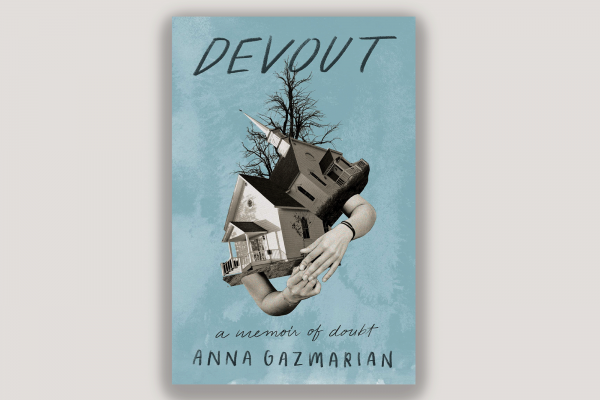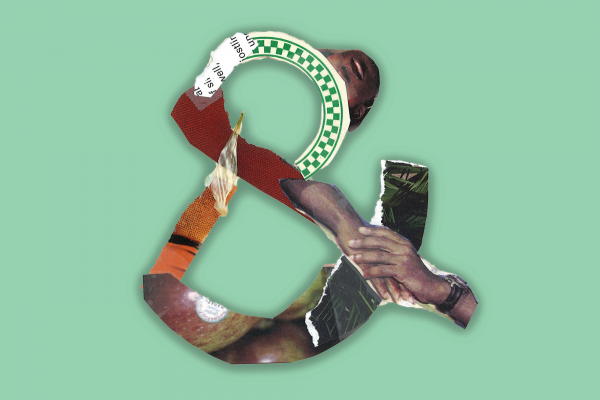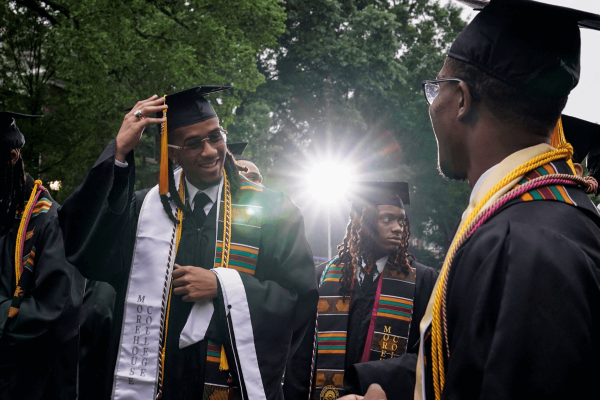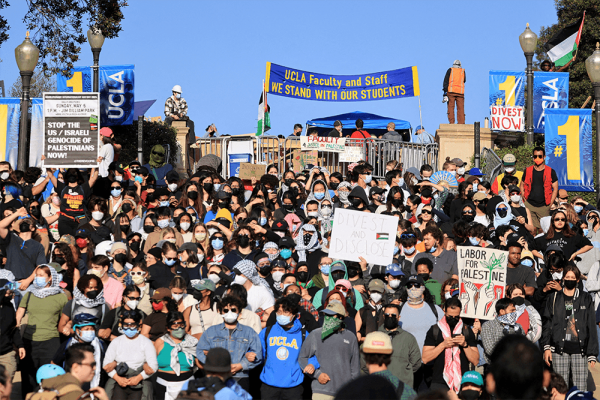Mother God is a gentle, rhyming children’s book that invites us to imagine the feminine qualities of the Divine, and to see those qualities in ourselves. Teresa Kim Pecinovsky writes, “God is our Loving Mother— / You are made in Her image too. / God calls you ‘Beloved.’ / She is making all things new.” Many of Khoa Le’s gorgeous illustrations portray modern mothers: a mother with a mohawk, a mother with an insulin pump, a mother nursing her baby next to a book labeled “Postpartum Depression.” Much of the text, however, is inspired by the Bible. God is portrayed as a human mother in labor (Isaiah 42:14), as a mother hen gathering chicks under her wing (Matthew 23:37), and as a mother bear guarding her cubs (Hosea 13:8).
I read Mother God a few times before I realized that the message of this tender book has the power to help us envision and create a different type of world. On one page, there is a picture of a woman kneading dough, under the text: “With a huge supply of flour / God kneads and bakes good bread. / She feeds Her entire neighborhood; They feast and all are fed.” I look at that page and imagine a world run by women and mothers. In my mind, it looks like the reign of God that Jesus modeled in the gospels: a world with bread, health care, and love for all.
Though the divine feminine is an ancient archetype, she’s having a cultural moment: In the 2016 Disney film, Moana restores the heart of Te Fiti — a lush island and nurturing goddess with major Mother Earth vibes. “God is a woman,” sings Ariana Grande in her 2018 song. “Step into your power,” Elsa sings to herself in Disney’s Frozen II (2019), in a hard-fought-for moment of self-love and radiant transformation. Fei Fei learns lessons about love and death when she visits a fabled moon goddess, Chang’e, in the 2020 Netflix children’s movie Over the Moon. In Sue Monk Kidd’s best-selling 2020 novel, The Book of Longings, Jesus’ wife, Ana, combats the sexism of her day and finds solace in Sophia, the female-personified Spirit of Wisdom from the Jewish Scriptures. In Lauren Groff’s recent novel, Matrix, a medieval nun connects to her own power through her devotion to the Virgin Mary.
“Mother Earth, Mother Mary, rise to the top / Divine feminine, I’m feminine,” sings Doja Cat in her 2021 song “Woman.” “What you need? / She give tenfold, come here, papa, plant your seed. / She can grow it from her womb a family / Provide lovin’ overlooked and unappreciated, you see.” As a society, we make a habit of overlooking and underappreciating those things we deem feminine. So why all this attention on the divine feminine now?
We might find the answer in Christena Cleveland’s 2022 memoir, God Is a Black Woman. Early in the book, Cleveland recounts an interaction she had with a white female sculptor the day after the 2016 presidential election. When the sculptor learned that Cleveland taught at Duke Divinity School, she told Cleveland how devastated she was by the results of the election. She asked if there was any hope, saying, “Where is God in the midst of this?”
“This is a question Black people have been collectively asking for centuries,” Cleveland writes. “It’s a question that more and more white women … have been asking since Donald Trump was elected and Judge Brett Kavanaugh was appointed to the Supreme Court despite being accused of sexually assaulting Dr. Christine Blasey Ford, a white woman … It’s a question that people are asking globally as the COVID-19 pandemic continues to collaborate with social inequality to ravage the most vulnerable. All over the world, the belief in a God who is with us and for us is cracking.”
God Is a Black Woman is about Cleveland’s quest to experience — not just believe in — a God who is with her and for her. Interspersed with social science, history, and personal anecdotes from throughout Cleveland’s life, the book recounts Cleveland’s walking pilgrimage through Auvergne, a region of France known for its many ancient Black Madonna statues. Of the Black Madonna in Mauriac, France, Cleveland writes: “I longed to gaze into her mysterious and kind eyes, to witness Her unyielding clutch on Her precious Black boy, to run my fingers along Her centuries-old dark, wooden body, and to stand before a sacred image of Black femininity.”
Each Black Madonna holds its unique personal significance for Cleveland. One story Cleveland tells is about the Black Madonna of Saint-Gervasy, who had been stolen, found, and — with the effort of the Saint-Gervasy community — returned home. “She can relate to our experiences of hopelessness because She too has been stolen. Even more, as a Black Mother, She knows the pain of stolen children too. She knows the pain of children stolen by mass incarceration, the war on drugs, systemic poverty, ableism, and other forms of violence. As someone who has endured the pain of personal loss and family loss, the Sacred Black Feminine empathizes with our pain and stands with us.”
As I read that section of God Is a Black Woman, I thought about a page in Mother God. A Black mother holds her son, while each of them cry. “She is the God who sees you. / God weeps, mourns and cries,” writes Teresa Kim Pecinovsky. “She comforts you through the longest night, / Keeping watch until sunrise.”
Though written for different audiences, both books present an image of a caring, maternal Divine figure, helping us imagine how society might be different if we saw God this way. As Cleveland notes, modern matriarchal societies — including the Khasi of northeastern India and the Mosuo of southwestern China — are not a simple reversal of patriarchal societies. Where patriarchal societies are centered around the needs of powerful men, matriarchal societies are centered around their community’s collective needs. Cleveland describes how Black queer women used their own experiences of rejection and exclusion to create “interdependent, safe, affirming physical and social homes for Black queer youth.” She also cites research on Black single mothers who have created communities where their children spend more time with caring adults than children of two-parent families.
As I read God Is a Black Woman, I found myself thinking of “The Combahee River Collective Statement,” written in 1977 by a group of Black lesbian women. This brief and radical document serves as the foundation for many of our modern-day discussions of identity politics and intersectionality: “If Black women were free, it would mean that everyone else would have to be free since our freedom would necessitate the destruction of all the systems of oppression,” reads one of its many vivid lines. Perhaps Cleveland had this line in mind when she wrote, “…social science scholars agree that what’s good for Black women is good for all people. The liberation of all Black women requires the dismantling of all the systems of oppression—white supremacy, patriarchy, capitalism, Islamophobia, homophobia, transphobia …These systems harm all of us. So, if Black women are thriving and free, it also means the oppressive systems have been eradicated and we are all thriving and free.”
What Cleveland calls “the Sacred Black Feminine” refuses to be “whitewashed and melted into the generic, anemic, ‘divine feminine’ pot”—because ‘the divine feminine’ alone will not liberate us from white patriarchy. She. Must. Be. BLACK.” In another section, Cleveland writes, “She is the God who definitively declares that Black women … not only matter but are sacred. She is the God who has a special love for the most marginalized because She too has known marginalization.”
Having endured a lifetime of dehumanizing treatment from the church, Cleveland no longer strives to make her work fit neatly within the framework of orthodox Christianity. However, her book often called to my mind the challenging teachings of the gospels, such as Mary’s statement in the Magnificat: “God has filled the hungry with good things and sent the rich away empty.” To the extent that we are privileged, good news for all may not sound like good news to us. We become like the man who responds to Jesus’ teaching “Blessed are the poor” by raising his hand and saying, “Blessed are *ALL* lives, Jesus,” as one satirical meme illustrated.
As a white woman, I am thoroughly down with smashing the patriarchy, but I found myself bristling at phrases Cleveland uses like “the generic, anemic ‘divine feminine’ pot.” Such phrases feel like an easy dismissal of material that has been profoundly moving for me … such as Frozen II. Like many little girls of the world, I love to belt out the lyrics of “Show Yourself” right along with Elsa. But I read Cleveland’s harsher words as a corrective against those of us who would stop there — at self-love —without allowing that love to reshape our society.
In these uncomfortable moments, I can see how many of my own feelings and actions are shaped by white privilege rather than a gospel message offering love for all while unapologetically centering the needs and dignity of those who are most marginalized. Of the Sacred Black Feminine, Cleveland writes: “Her circle is wide and all are welcome. But just because all are welcome doesn’t mean all are ready.”
Got something to say about what you're reading? We value your feedback!







